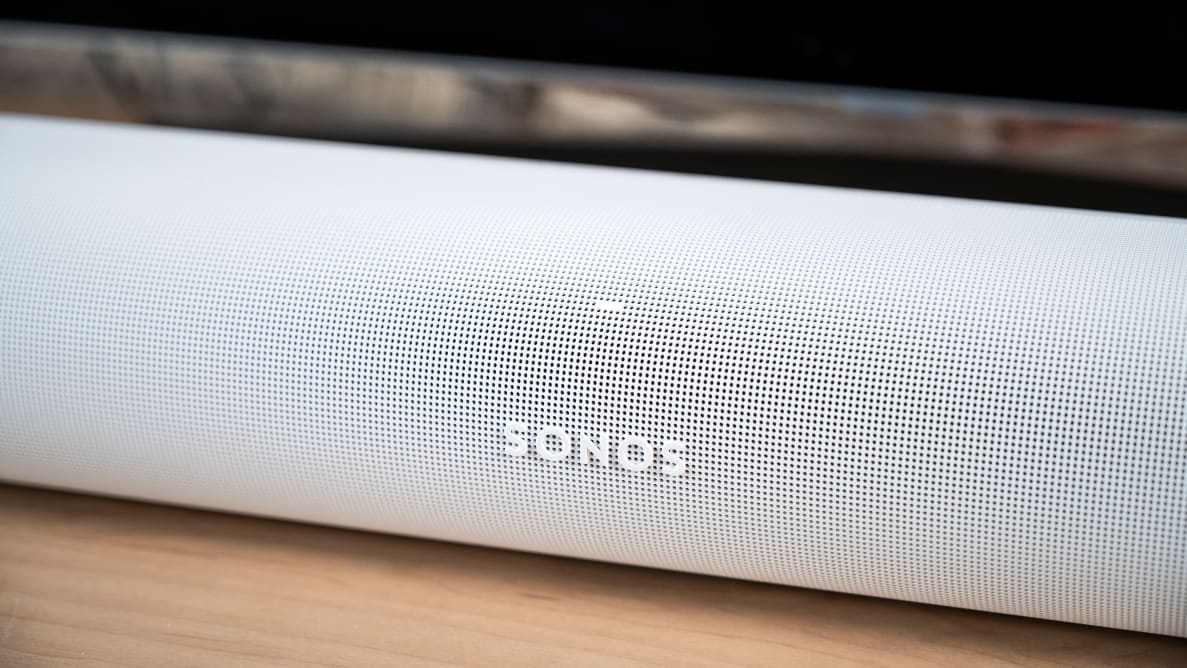Pros
-
Rich, powerful sound
-
Hands-off interface
-
Sonos style and versatility
Cons
-
Dolby Atmos limited to newer TVs
-
Short on inputs
-
Big and heavy
Updated November 2, 2022: This review has been updated with new info, including a supply-chain price rise to $899 (which doesn't seem to be going away), the addition of 5.1 support for DTS, and the now-available Sonos Sub Mini.
Unlike multi-speaker systems such as Samsung's HW-Q990B, the Arc doesn’t include satellite speakers or a wireless subwoofer, meaning it doesn’t offer a full surround configuration. Instead, in true Sonos fashion, you can build a piecemeal surround system by adding speakers like the Sonos One SL (or the more affordable Symfonisk) and a Sonos wireless subwoofer, pushing the price more in line with other premium Atmos bars. Since the bar's release, this has become a common form factor in the genre.
At $800 on its own (now $899 with a price rise due to claimed supply chain issues), the Arc won’t appeal to everyone. That includes those on a budget or, on the flip side, home theater enthusiasts who may balk at its short supply of inputs and lack of advanced sound settings. A lack of spare HDMI inputs also limits Dolby Atmos compatibility to those with newer TVs (around 2017 or later).
But make no mistake, this is a powerful, well-tuned soundbar that blends rich, engulfing sound with Sonos convenience. That should put the Arc on the list of anyone in the market for a premium soundbar—especially those already entrenched in the Sonos ecosystem. In fact, it's our overall pick for the best soundbar you can buy, and also one of the best Dolby Atmos soundbars.
About the Sonos Arc soundbar

Here’s a snapshot of the Arc’s basic specs:
- Height x Width x Depth: 3.4 x 45 x 4.5 inches
- Weight: 13.7 pounds
- Colors: Black, White
- Speaker/drivers: 8 elliptical woofers, 3 silk-dome tweeters
- Amplification: 11 class-D digital amplifiers
- Wireless connection: Wi-Fi, Spotify Connect, Apple AirPlay 2
- Wired connection: Ethernet, HDMI ARC/eARC, digital optical adapter
- Sound formats: Dolby Digital, Dolby Digital Plus, Dolby TrueHD, Dolby Atmos, DTS 5.1, LPCM
- Smart features: Amazon Alexa or Google Assistant built-in
- Other features: IR repeater, Sonos Trueplay room calibration (iOS only)
The Arc is loaded with 11 individually powered drivers, including 8 oblong woofers and 3 silk-dome tweeters. Two upward-firing drivers and dual side-firing drivers are designed to bounce sound off your ceiling and walls, and two of its tweeters are also angled toward the side in an effort to expand the soundstage up front.
Like the Sonos Beam, the Arc offers onboard microphones to activate your choice of Google Assistant or Alexa. Supported features include smart functions like checking the weather or controlling smart home components, as well as playback controls like play/pause and volume control.
The Arc offers Wi-Fi connection, of course, including Spotify Connect and Apple AirPlay 2 support. Wired connections include Ethernet and a single HDMI ARC/eARC port for receiving input from your TV. The bar includes a digital optical adapter but no analog inputs or spare HDMI inputs for connecting components directly. Notably, the Arc also ships without a remote, though it can be seamlessly controlled by your TV remote and/or the Sonos app.
What we like
Snappy performance
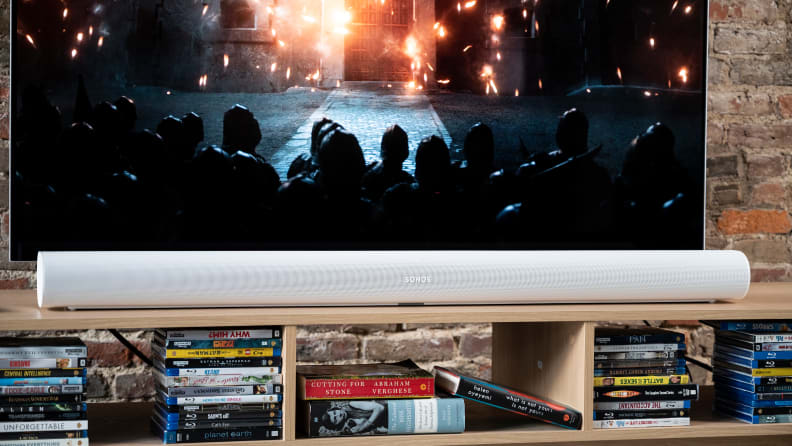
One thing Sonos excels at is cobbling complex setups into an intuitive system. That’s evident for the Arc from the get-go. After downloading Sonos' S2 controller app, it walks you through every step from connecting the bar to your TV’s HDMI ARC input to adding streaming services. The bar is very quick to action, and I was playing back both music and TV content in minutes.
I rarely found myself needing to adjust sound levels—which is a good thing given how limited the controls are (more on that below). And even without the use of Sonos’ room-tuning Trueplay (sadly confined to iOS), the Arc quickly assimilated with my room.
I was originally unable to connect either Google or Alexa voice assistants via Sonos’ Beta app. Since then, however, we've retested the bar with the updated S2 app and had no problems using smart assistants for basic playback control, alongside the usual smart queries.
An interface you can hold in your hand

Maybe the biggest compliment I can give Sonos on usability is just how long it took to dawn on me that the Arc doesn’t include a remote. In the age of HDMI ARC, soundbar remotes are increasingly unnecessary since you can control primary functions (e.g. power and volume control) with your TV remote. Without the need to tune a subwoofer or surrounds, and with all other functionality available on the well-designed app, I simply forgot that I’d normally be grabbing for the remote.
All essentials, from Night Mode and dialogue boost to the basic two-band EQ are at the ready from your phone. You can customize settings, such as turning off the rudimentary display LED (which indicates source), or group with other Sonos speakers for multi-room playback or surround sound.
The bar lacks settings like preset sound modes (which I rarely find useful anyway), and it auto-tunes between stereo and surround tracks, making it among the most hands-off Atmos systems you’ll come across—perfect for beginners.
Premium, powerful sound
The first real audition I gave the Sonos Arc was Marvel’s Ant-Man streamed over Disney+ in Dolby Atmos—and what an audition it was. I'm not sure if it was my lack of expectations for a singular bar or the film's constant morphing between the macro- and micro-worlds, but the result was a strikingly potent and engaging sonic adventure.
From the thwump of the wings in Hank Pym’s flying-ant army to the clear dialogue, the film shows off the absolute best of what the Arc has to offer (and vice versa). Details popped, the soundstage swelled around the front of the room, and the colorful resonances of each new environment were beautifully rendered by the Arc’s clean and smooth sound signature.
A favorite moment came when Ant-Man and YellowJacket fell inside an iPhone; Siri’s voice seemed to chirp from above, tricking me into thinking I’d wandered into the scene, while The Cure’s “Disintegration” bloomed in the room bigger than I’ve ever heard it. Though the soundstage never fully reached behind me, it was grand enough to make a serious impression; at one point I even wrote in my notes that the Arc was upstaging the visuals on my 4K HDR TV.
Other Atmos explorations were less dramatic, but there were plenty of impressive moments, from the buzzy grind of Star-Lord’s spaceship (I’m on a Marvel kick) to the speckled rain in Dolby’s “Amaze” Atmos demo scene. Bass doesn’t dig down to the spacey depths of a designated subwoofer—especially notable in Atmos demos designed to kick out the lowest frequencies your subwoofer can handle—but it’s more than enough to bring gravitas to action scenes and energize the higher registers.
Unsurprisingly, sound floated down to earth on stereo mixes of old sitcoms like Seinfeld, but details were still notable and dialogue was smooth and rarely shouty. Occasionally in the quietest moments of shows like The Wire, I became aware of the Arc’s digital processing as there seemed to be a slightly metallic color to voices. But that's being pretty nitpicky—I mostly just enjoyed the ride.
Similar to most soundbars, stereo music over the Arc is also flatter and more static, though still enjoyable. The Arc does best with richer productions like The Weeknd’s “Starboy” or Snarky Puppy’s “Jefe," while more acoustic-oriented tracks were less dynamic and sounded more processed. The best music reproduction by far came from Atmos tracks in films, especially notable in the Guardians 2 soundtrack; George Harrison’s "Sweet Lord" on Ego’s home planet was a revelation. Luckily, now that Dolby Atmos Music tracks are available over Tidal, there are more chances to explore it than ever.
A few minor quibbles aside, the word that keeps coming up when describing the Arc’s sound signature is “premium.” It really does deliver on its promise there, and those looking for tactile detail and cinematic pop will find both in spades.
The benefits of Sonos
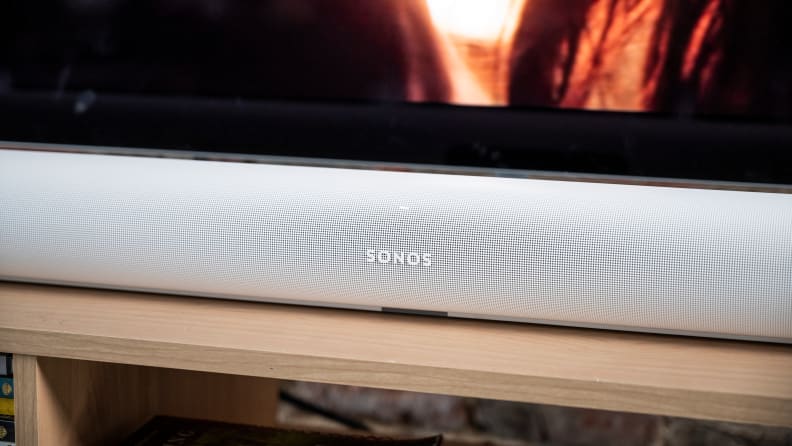
Designed more as a holistic speaker than one made for enthusiasts, the Arc's design restricts some home theater applications (which we’ll discuss below). But it’s also worth pointing out some of the cool things it can do as a Sonos device.
Along with the ability to add satellite surround speakers and a subwoofer, the Arc can be seamlessly grouped with other Sonos speakers for a multi-room audio solution. While the sub is a particularly pricey upgrade, the 2022 release of the Sonos Sub Mini($429) lowers the impact to your wallet significantly, though it's still pricey.
Sonos hosts a hearty array of supported streaming services, access to plenty of others via AirPlay 2, and also lets you source lossless audio files from a NAS drive. And, of course, continuous updates to the app allow for new features down the road.
In short, you’re not just paying for the Sonos brand, but also for the benefits of a broader system unified through powerful software.
What we don’t like
A short supply of inputs limits use cases
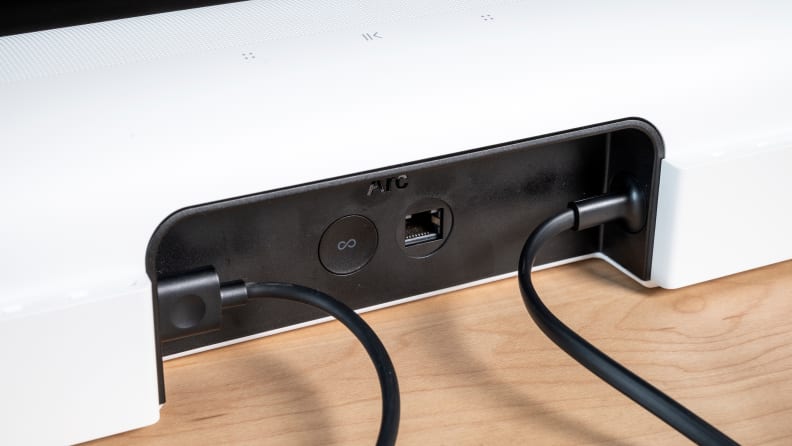
While there’s plenty to like about owning a powerful Atmos device in the Sonos family, the Arc's minimal layout leaves something to be desired, especially for A/V enthusiasts. There’s no analog connection or separate digital optical port for legacy devices, for instance. And like almost all Sonos products, there’s also no Bluetooth support.
The bar’s lack of an extra HDMI input is the main concern, though. This not only robs a TV input if you connect via HDMI ARC (necessary to source Atmos), but it also makes getting Dolby Atmos sound more complicated.
For example, if your TV is too old to passthrough Dolby Atmos (basically if it doesn't support Dolby Digital Plus) you can't get Atmos at all, as there's no way to simply bypass the TV by connecting a streaming box or Blu-ray player to the Arc directly.
This also means the Arc can’t source uncompressed Dolby Atmos signals from outboard components, some of which may not support Atmos without it. The Arc’s support for HDMI eARC means that it can source uncompressed audio from a device connected to your TV—but only if you have a newer TV that also supports eARC connection. In short, total reliance on your TV for surround sound output comes with notable limitations.
A lack of home theater trappings
Continuing on the minimalist theme, the Arc’s plug-and-play design makes for simple operation, but also allows for fewer ways to adjust and tinker with settings than the vast majority of competing devices.
For instance, while the app makes it easy to adjust the volume and EQ of add-on Sonos speakers, you can't adjust individual drivers such as the center channel. Luckily, Sonos did add the ability to control the height channels with an update to the S2 app in May 2021, which could be crucial for those with higher ceilings. And in my original evaluation, I rarely felt the need to make adjustments, as the Arc is so well-tuned. I did occasionally wish I could ramp up the center channel for dialogue—there is a dialogue boost, but it also makes the upper register sharper.
Another major hole in the Sonos Arc's home theater offerings has long been its lack of DTS support. That means those with an extensive Blu-ray collection had to set outboard devices to output PCM for DTS audio tracks to play at all, which also excludes DTS:X, the biggest rival to Dolby Atmos. Sonos officially has "nothing to share" on DTS:X, but an update to the S2 app adds DTS Digital Surround (5.1) as of November 16. We wish the brand would add increased support, and support may also depend on your TV since you can't connect outboard devices to the bar directly, but the addition is a step in the right direction.
I wish the Arc had a subwoofer at this price, but it does quite well on its own without one. We're increasingly seeing this "add-on-later" design approach in Atmos soundbars as the technology continues to creep further, from Bose's Smart Soundbar 900 to Sony's HT-A7000 and HT-A5000. It's obvious a lot of buyers simply want a standalone playback device for various reasons. While you may pay more per component, this does give you a choice of where you spend your money.
Mega-bar
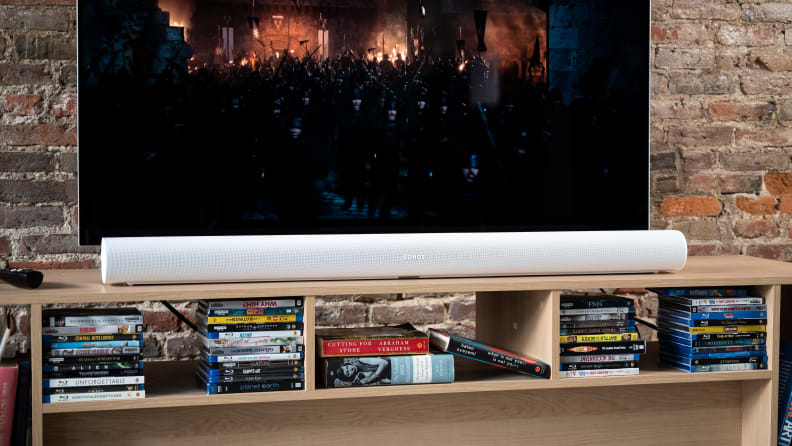
At 14 pounds, 4 inches tall, and 45-inches across, no one will be calling the Arc dainty. Its size, particularly its height, means it may cover up the bottom of some TVs—Sonos built in the IR repeater for just such an issue—and you’ll pay another $79 to mount it.
A honking chassis isn’t uncommon for Dolby Atmos bars, though, and the Arc’s size helps it create robust bass response and seamless fluidity between the low and high registers—something smaller bars of all price points struggle to achieve.
Should you buy it?
If you've got the right setup, absolutely
Despite its lack of home theater features and its large-and-in-charge size, the Arc delivers all the joys of Sonos ownership (from multi-room audio to smart assistant control) alongside seriously impressive sound. It’s not cheap, but it is a relatively affordable way to step into Atmos, allowing for the ability to upgrade over time with uniquely versatile components. The ease of use is also paramount to the experience, making this a great bar for novices or those who want less fuss from their sound device.
The main caveat is, if you're all about Dolby Atmos, you'll want to make sure your TV is either compatible with Dolby Digital Plus or, better yet, supports HDMI eARC connection. Luckily most new TVs offer both, including virtually every choice on our list of the best TVs.
With a maximum of two up-firing drivers, even after you’ve added on satellite surrounds, the Arc won’t be quite as immersive as Atmos bars with the maximum 4 height channels, such as Samsung’s aforementioned HW-Q990B. Vizio's excellent Elevate soundbar also offers a full multi-speaker setup for around the same cost as the Arc, while Sony's HT-A5000 is a great alternative for those who want a spare HDMI port for gaming consoles or Blu-ray players.
Still, those looking for a premium audio experience in a singular bar will have a hard time beating the Arc. It's easily one of the best-sounding one-piece Atmos systems you can buy, and its ease of use and versatile buildability make it a top pick for all sorts of buyers.
Meet the tester
Hailing originally from Montana, Ryan parlayed his time working as a musician and audio engineer into a career in digital media in 2012. Since then he's had extensive experience as a writer and editor, including everything from op-eds and features to reviews on TVs, audio gear, smart home devices, and more.
Checking our work.
Our team is here to help you buy the best stuff and love what you own. Our writers, editors, and experts obsess over the products we cover to make sure you're confident and satisfied. Have a different opinion about something we recommend? Email us and we'll compare notes.
Shoot us an email
